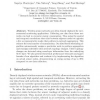Free Online Productivity Tools
i2Speak
i2Symbol
i2OCR
iTex2Img
iWeb2Print
iWeb2Shot
i2Type
iPdf2Split
iPdf2Merge
i2Bopomofo
i2Arabic
i2Style
i2Image
i2PDF
iLatex2Rtf
Sci2ools
DCOSS
2007
Springer
2007
Springer
Energy-Efficient Data Acquisition Using a Distributed and Self-organizing Scheduling Algorithm for Wireless Sensor Networks
Abstract. Wireless sensor networks are often densely deployed for environmental monitoring applications. Collecting raw data from these networks can lead to excessive energy consumption. Thus using the spatial and temporal correlations that exist between adjacent nodes we appoint a few as representative nodes that perform in-network aggregation. This reduces the total number of transmissions. Our distributed scheduling algorithm autonomously assigns a particular node to perform aggregation and reassigns schedules when network topology changes. These topology changes are detected using cross-layer information from the underlying MAC layer. We also present theoretical performance estimates and upper bounds of our algorithm and evaluate it by implementing the algorithm on actual sensor nodes, demonstrating an energy-saving of up to 80% compared to raw data collection.
DCOSS 2007 | Distributed And Parallel Computing | Raw Data | Topology Changes | Wireless Sensor Networks |
Related Content
| Added | 14 Aug 2010 |
| Updated | 14 Aug 2010 |
| Type | Conference |
| Year | 2007 |
| Where | DCOSS |
| Authors | Supriyo Chatterjea, Tim Nieberg, Yang Zhang, Paul J. M. Havinga |
Comments (0)

